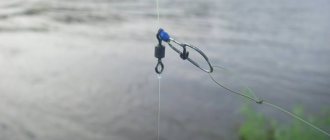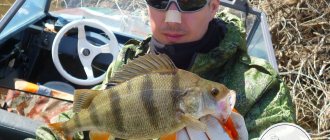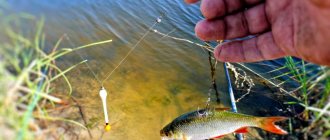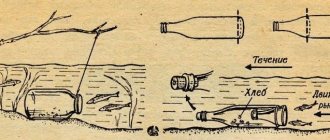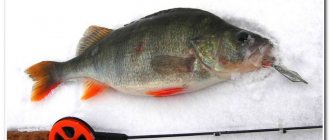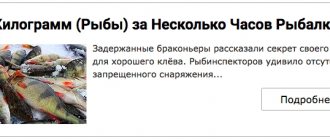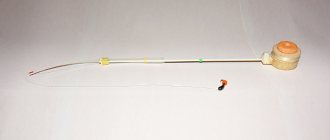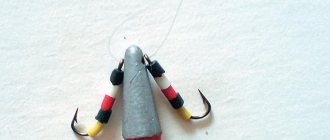Before you start catching the perch itself, you first need to catch the bait, namely the fry. The best type of fish to use is crucian carp, since it is very tenacious and will not die for a long time while on the hook. Also suitable as live bait are fish species such as roach, rudd, small tench, etc.
To catch fry, it is best to use a “spider” - a network device that allows you to catch a large number of small fish (30-50 pieces) in a minimum amount of time (an hour). To catch fish with this device, you first need to lower it into the water, and pour on top the bait that small fish love: bread crumbs, crushed worms, semolina or maggots. However, fry are often caught with a regular float rod.
What, where and when to lure perch
There is nothing complicated in the fishing technique using natural baits. Catching "minke whales" with live bait is done after they swallow the bait placed on the hook. It is advisable to fish for perches using those inhabitants of the underwater world that live with predators in the same water area. These can be small crucian carp, roach, minnows, minnows, verkhovkas, bleaks.
If you try to catch the desired trophy with live bait, which is not in the river, lake, or pond, the “humpback whale” can completely ignore it, and if it pecks, it will be weak. Only habitual food will force the predator to actively swallow the bait.
You should not get carried away with catching exotic live bait, even if they have proven themselves excellent in other places. But this predator will almost always be tempted by crucian carp.
In places for hunting, perch chooses clean areas of the water area, hiding in thickets and snags. Depending on the time of year, it can live at different depths. Medium-sized individuals like to live in backwaters with dense underwater vegetation, and only in the autumn do they come to open areas. Large “humpback whales” live in the depths, appearing on the surface only in the morning and before sunset. As a rule, “minke whales” stay in the same areas and rarely leave them.
In ponds and lakes with stagnant and muddy water, perch chooses unpolluted places near bottom plants. In rivers it also prefers thickets or areas with a not too fast flow near snags, boulders, logs and stones.
To learn more:
Using a fishing elastic: what kind of gear is it?
Perch using live bait in the spring, summer months and fall is caught almost equally. This fish goes hunting at dawn and stops feeding after sunset. She doesn't bite at night. The most convenient time for catching is early morning on a cool day. The predator shows its activity by chasing schools of other fish. The process is clearly visible close to the coast in the warm season. The presence of “humpback whales” is determined by the fry’s jumping out of the water.
Catching perch with live bait in winter is a little different from fishing in summer and autumn. During the frosty season, “minke whales” roam throughout the reservoir, looking for deep areas. They break up into small flocks, and a fisherman who has caught 5-6 individuals in a row urgently needs to change the fishing location.
How to properly hook
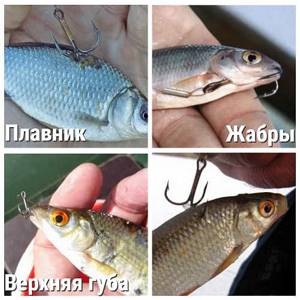
There are several methods of baiting and each fisherman chooses the best one for himself. Some can be implemented faster, while others require a little more time for installation. All of them are reliable and simple in nature. After fishing, you will determine for yourself the best option, which has the least number of gatherings and which allows the fish to live as long as possible. The latter is extremely important, since the striped bait is not interested in dead bait.
- Through the gills. The leash is threaded through the gills and pulled out of the mouth. Next, a double is put on him. The fishing line is stretched in such a way that the entire forend is completely hidden in the mouth, and 2 hooks point downward, in the form of fangs.
- Behind the back under the upper fin. Thanks to this method, the fish live the longest, with a high hook rate and good bait activity. It is possible to use both single and triple hooks.
- For the upper lip. The hook is threaded through the upper lip with the tip facing up. Perch, like other predatory fish, attacks its prey from the head, so this option has a high grip.
- Per head. It clings to the area where the body and head connect; it is important not to insert the sting deeply, as if you overdo it, you will seriously damage the fish; in the end, it will not survive even 10 minutes.
Pros and cons of live bait fishing
The advantage of this type of hunting is that using a small fish as bait allows you to catch larger-sized perch (pike, trout, pike perch can also bite) compared to using maggots or worms. The disadvantages are the difficulty of placing live bait on hooks and problems with the delivery and storage of such baits. Let's not lose sight of the ethical side of the issue.
Unlike spinning fishing, using live fish as bait allows trophy hunters to wait for a bite in one place and not have to travel along the shoreline, and there is no need to make frequent casts. Catching perch in this way can be combined with waiting for peaceful fish to bite on other fishing rods.
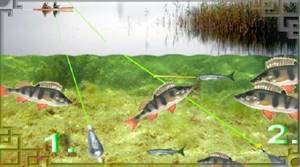
Important introductory note
A simple freshwater river perch is one of the many representatives of ray-finned fish, which, in addition to it, also includes such well-known fish as Ruff, Blue Marlin, Ratan and many other predatory and relatively predatory species. From this we can reasonably conclude that ray-finned fish have settled well almost everywhere - from the endless waters of the Pacific Ocean to little-known rivers like the Miass, which flows in the depths of the Eurasian continent.
One of the most famous and widespread fish of this family is our today’s hero - river perch. So much has already been said about him that there is nothing to add. However, we will still try to tell you a little more about this little sharp-finned and striped prankster than usual.
The perch attacks so quickly and selflessly that sometimes it seems as if lightning flashed over the surface of the water. Therefore, fishing with live bait can be either very successful or not at all as the fisherman himself would like.
At this stage, a reasonable question arises: where to get live bait? In fact, everything is very simple. The first thing you need to do is bring a jar of worms and a piece of bread with you to the pond. Periodically, alternately feed the fish first with one delicacy, then with another snack and wait. Soon there will be many small-sized fry and simply not large enough “trash” fish, among which, of course, the perch itself may be present.
There is nothing wrong with using perch as bait for another - its larger brother. Perches are cannibals, not all, but many. Adult individuals are excellent at distinguishing their own kind, but for some reason some of them do not disdain to feast on perch flesh at their leisure. These are the preferences that can only be explained by the presence of some kind of innate program designed to independently prevent an overabundance in the striped population.
Choosing fishing gear
Catching perch with live bait is impossible without using one of the following means:
- reliable float rod;
- well-balanced jig;
- high-quality bottom tackle;
- circles - zherlits.
Float equipment
The most popular equipment for this type of fishing is a float rod. To install the equipment, you will need a stick with an unsteady top to softly absorb the cuts. The fishing line should be 0.22-0.25 mm in diameter and green or neutral in color. It must be wound exclusively on a spinning reel.
To learn more:
Mainline boilies for carp fishing
The load must be selected in such a way that the live bait has a certain freedom, but at the same time cannot insert the equipment into snags or reeds. The float must be proportionate to the shipment (usually 5-10 g). Both for fishing from a boat and when fishing from the shore, sliding models are used. The rig requires hooks numbers 5-10 with a long shank, which are easier to remove from the mouths of voracious perches. It is advisable to refrain from using stings made of thickened wire - they injure live bait.
Throw the bait in a neat pendulum manner, so as not to stun the bait by hitting the surface of the water. When bitten, the perch will move the float with a sharp movement to the side, drowning it. It is necessary to hook immediately, since the predator swallows the bait on the move.
Using a jig
In calm water, experienced fishermen often use this type of equipment, adding live fry as additional bait. This type of tackle allows you to avoid snags in places where fishing on a float is accompanied by numerous breaks.
In the warm season, a vein of 0.17-0.22 mm is taken, and in winter the line should be even thinner, in the range of 0.13-0.14 mm. The fact is that in icy water even predatory fish are not very active, and the use of rough tackle can scare them away. In order for the catch to be effective, it is necessary to play with the jig both at the bottom and in different layers of water. The activity of the predator and its bite are monitored by a lateral nod.
Catching perch with bottom tackle
The equipment is used regardless of the time of year, but it becomes most effective in August-November, when the fish move to the depths. The popular classic donka is a tackle with a short rod, an inertia-free reel (an old Neva “drum”), a strong core, a weight and a leash with a hook (you can use several leaders, placing them above the lead weight).
The baited bottom must be cast smoothly so that the bait remains intact. With its help, they catch lonely snags, flooded bushes and other places where the float rod does not work due to the large number of hooks. Before hooking the prey, it is advisable to pause and even unwind a little of the vein. The perch swallows the prey in motion, and when it feels resistance, it can throw the bait.
To learn more:
Sbirulino float rod
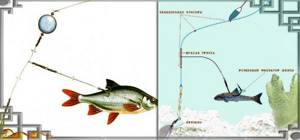
Zherlitsy and mugs
The equipment is almost no different from those used to catch pike, except in size. For installation you will need:
- main line with a diameter of 0.3 mm;
- reliable leash 0.2 mm thick;
- light lead weight;
- a hook that matches the size of the bait fish.
The bait is set at the expected depths of habitat for a school of perches. In late spring and summer - at half-water, the rest of the time - deeper. To make fishing more catchy, you need to install 3-4 girders in a circle, and pour small bait into the center between them. A peaceful fish will soon approach the spot, and predators will follow.
Float trolling
Above we talked about catching perch with live bait by casting, but sometimes it is more productive to catch perch with fry using the float trolling method. It allows you to check large areas of water and find schools of fattening perch. In addition, when you catch perch with a small fish cast, the bait often flies off, but when trolling it always remains intact.
Trolling with float rods with baited fry is carried out like this. At the stern of the boat, the fisherman places one or two fishing rods and swims very slowly, rowing with oars. The speed should be such that when moving the float the float is not pulled under the water. The line release from the tip of the rod to the float is 10-15 m. A longer release is not needed, since the feeding perch of the boat is not afraid. If you use two fishing rods at once, even if they are widely spaced, during long-distance releases and maneuvers of the boat, the float rigs come closer to each other and can get tangled.
I usually use a one-person rubber boat for float trolling. The question may arise: will the perch be afraid of a boat passing near the school? Not only will it not be afraid, but, on the contrary, when the boat passes near reeds, sedges, cattails and other aquatic plants, schools of perch become more active. This is due to the fact that when the boat moves, the fry becomes animated and comes out of its hiding places into spaces clear of algae, which provokes the perch to attack. Sometimes I deliberately point the boat at the seaweed to drive the fry out of there. This is often followed by a perch bite.
The length of the fishing line from the float to the bait should correspond to the depth of the water area in which trolling is carried out. During the retrieve, even if you move at a very low speed, the fry, when rowing with oars, rises much higher than the bottom, and when the boat slows down, it falls down. This is the horizon on which you should catch perch. For this kind of fishing, a leash with a length of 40-60 cm is used. A load of 5-10 g usually consists of one to three shifted lead pellets. But to prevent the fry from flying up too high, you can increase the weight of the load by using a sliding “olive” weighing 7-15 g as the main sinker. This will also entail an increase in the carrying capacity of the float. In general, when fishing this way, it is enough to have just one fixed lead sinker on the line near the leash, which will ensure constant tension of the line between the weight and the float. Then, when the oars move, a pendulum effect is created: the fry on a long leash either flies up into higher layers of water, then falls down, which attracts perch. To prevent the float from sinking when being deployed, it must have two attachment points - near the antenna and on the keel.
Read! Catching tench in early spring with a fishing rod
The route of the boat should pass along thickets of reeds, sedges and other algae, near which the perch chases the fry. You cannot ignore the islands on lakes and reservoirs, near which dense schools of perch of various sizes often gather. On the dammed tributaries of reservoirs you can also find suitable areas for such fishing.
How to catch good baitfish on a pond
The easiest way is to buy such a nozzle in a store or market. But it may happen that this delicate cargo does not reach the fishing site safe and sound, so it will have to be obtained on the spot. Catching small fish is not difficult. On many lakes and ponds, it is enough to go into the water some distance from the shore and scoop it up with an ordinary jar, and a couple of fry will be caught. But this does not always give the desired result, especially where the density of fish is not very high, and besides, catching live bait in the fall or winter does not take place in such comfortable conditions as in the summer.
To catch small fish, predator hunters use “baby traps” or small screens. Before installation, it is advisable to feed the area with bread. The presence of any food will attract small fish. The “baby fish” is installed closer to the bottom, and when a lot of live bait has gathered on the surface, the tackle is raised. This way the net will contain the required amount of future bait.
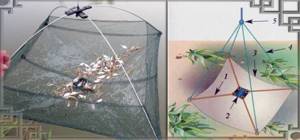
If you wish, you can use a float rod with a small hook and catch crucian carp, roach, bleak, and minnows in an honest way. But the method is acceptable only in cases where there is no perch activity or the time has not come for hunting.
How to choose gear
Perch, as you know, is not the most picky fish. Even an ordinary float fishing rod, equipped with a simple non-inertial reel, a simple fishing line with a diameter of 0.5 millimeters, an ordinary spoon, provided that there is live bait, will bring you the treasured catch. The main thing is to remain calm and steely self-control, without interfering with the process of moving the bait itself through the water, otherwise the humpback will sense a catch and hide between its stones, leaving you alone with the fry.
Fishing for fry and catching perch video
Fishing for perch using live bait is one of the most effective ways to defeat a cunning opponent in a fight. We are talking about humpback whales, while small perches are unlikely to be at all interested in fish as bait, because the basis of their diet is various microorganisms.
For a better understanding of the material presented here, we recommend watching this video, which may be useful and instructive for you. Try not to neglect the advice given in this article. Ultimately, the success or failure of all your endeavors and attempts to achieve an outstanding result and finally get the desired trophy will depend on this.
Live bait bait methods
Before you properly hook a fish, you need to select the appropriate size of both the sting and the bait. If the tip is large, the baitfish will quickly die, and the small one will slip off. Dress the fish in several ways:
- The hook is hooked onto the tail, having previously wrapped this area of the baitfish with a thread made of nylon or nylon.
- Carefully pierce the area of the upper fin. In this case, you must be extremely careful not to damage the fish.
- The hook is passed through the mouth and out through the gills. This method is the simplest and most reliable.
To learn more:
Catching chub in October with a spinning rod
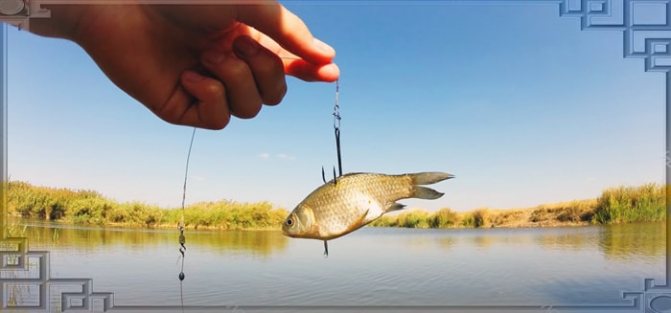
Small fish for bait
Schooling perch are attracted by any small fish, sometimes even very large ones. It happened more than once when a perch was actively biting that as soon as you looked at it a little, the small perch managed to grab an oversized fry and swallow it. Any small fish is suitable as bait. More often these are roach , bleak , verkhovka and even perch. In autumn, the water becomes colder and the fry are perfectly preserved. Once caught, the fry are enough for two or three fishing trips. At the same time, it is not necessary to store them in a canna that has a lattice container inside. To preserve the fry, an ordinary plastic canister with the upper part of the body cut off is suitable. It is more convenient to remove the fry from the container with a small net. It is best to store the container with fry between fishing trips in a cold place, for example in the basement. Sincerely, blog author
Storage and transportation of live bait
Buying or catching small fish is far from a guarantee of successful biting. Many people know how to catch the desired live bait, but they must be delivered to the fishing site unharmed and stored correctly on the shore. Heating the water in the tank where live bait is kept is the main problem. It is necessary to place the bait in an enameled (in no case galvanized) or plastic bucket with a volume of 10 liters.
Cold water is poured into the container, seaweed is placed on the bottom (so that the fish do not shake during transportation) and a plastic bottle (container) with frozen ice is lowered into it. A cooler bag is suitable; glass jars with fish are placed in it, adding bottles of ice for safety.

On the shore, it is convenient to keep live bait in a cage with small cells, submerged to depth. It is important to remember that in the coastal zone the water is always much warmer. Roach, rudd and verkhovka are the first to withstand temperature changes. The minnows flounder in the bucket a little longer. The hardiest are small crucian carp. You also need to take into account the fact that perches removed from the water do not live long. In cages they quickly turn belly up. Therefore, caught fish must be quickly processed and used for its intended purpose.
How and where to catch perch with live bait is up to each trophy hunter to decide for himself, but we must remember that in many European countries this technique is prohibited and is considered a barbaric method. To avoid trouble, you need to familiarize yourself in advance with the rules of fishing in a particular body of water.
A spoiled mood and a large fine are not worth the pleasure that fishing with live bait gives. But on your native lakes, rivers and ponds you can hone this method to the point of professionalism.
Fishing technique and choice of live bait
Before you start fishing, you need to prepare everything you need.
In addition to gear, a fry is required, which acts as live bait. Using the experience of fishermen, you can avoid a lot of mistakes and end up with a good catch. First of all, let's look at where to get the bait, because the size sold in stores is too large. This is used for catching pike, but not for perch - it will not be able to swallow it. In addition, it would be good to know which fish are ideal for this task and which are better not to use.
Who can be used as live bait and how to choose its size
Most fish used in this capacity live in all bodies of water. Some species will be impossible to find in the fall, but in the summer there are more than enough of them. Therefore, the time of year plays a role. Moreover, some of them are picky about their living conditions and have a short lifespan.
The latter does not matter if you use it right away, but what if you need to get to the place and have a long journey ahead? A sluggish and motionless bait attracts much worse.
Main types used:
- Crucian carp. Is the best choice. Its main advantage is its unpretentiousness to storage and transportation conditions. Capable of being with a minimum amount of oxygen for a long time, maintaining activity. Catches both perch and pike. A suitable size is often sold in fish farms; in ordinary stores it is usually too large.
- Rudd. A good choice if you fish immediately after catching it. Doesn't last long and is difficult to preserve. The pluses are the size - it is ideal, as well as the ease of extraction (read below).
- Bleak (high water). Its main disadvantage is seasonality. At the same time, it spawns from late May to early July, so summer is ideal. It is also easy to catch in large volumes, and retains its mobility well after being hooked.
- Juveniles of other fish. The perch itself is also suitable, because the predatory fish does not distinguish between friends and foes. Another thing is that it is much more difficult to obtain other species than the ones listed above, and therefore are rarely used.
Methods for extracting live bait material
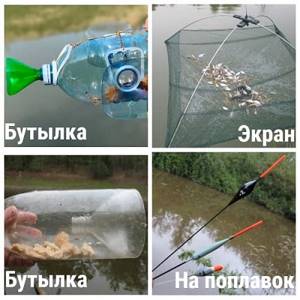
- Screen. The most popular, simple and catchy method. It is a square mesh with a fine mesh and arcs with a rope for attaching to a stick or fishing rod. In the summer, it descends to a shallow place with warm water, and in the fall it moves closer to grass and thickets. Top with breadcrumbs or bread. After 2-3 minutes of waiting, the screen rises. In it you will immediately find 10-20 pieces of ideal-sized live bait for perches.
- Float rod. A longer process that does not allow you to catch many fish at once. The process can be speeded up by knitting several hooks, but this still does not compare with the screen. More often you come across larger specimens. On the current, when fishing with a wire in the surface layers, you can successfully catch the required amount. To attract the attention of the fish, use bait, mainly breadcrumbs and mixtures (grated biscuits), which create a cloud of dust.
- Bottle trap for fry. If you have time, you can resort to this method. You will need 4 plastic bottles, 5 liters each. For 3 bottles, the neck with the skirt is cut out, then the necks are inserted from 3 sides into one bottle so that the skirt faces outward (see photo). A couple of pebbles are placed inside for weight and bait in the form of black bread. Next, the trap is placed on the bottom and you just have to wait for the fish to swim into it. We recommend using 5L bottles, because their neck diameter is much larger than 1.5L.
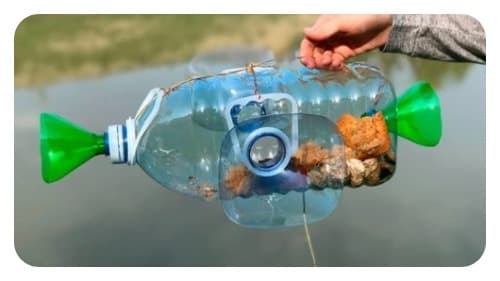
How to save the fry and bring it to the fishing site alive
For a short time . After purchase, it should be placed in a bucket or can - a special container for storage and transportation. It is important that the volume of the container is as large as possible, especially with its high density. The same goes for storing fish for a day or two. You should not use tap water; it may contain large amounts of impurities and chlorine.
Ideally, take water from the same reservoir, and if purchased, drain it from a common storage area. In this way, the temperature and composition of the water will be maintained. At home, pour the fish into a container so that it fits on a shelf in the refrigerator. In the summer, at home, the refrigerator is storage place number 1.
For a long time . Often fishermen stock up on live bait for a long period of time, this can be more than one month. In this case, the preservation methods listed above will not work. It's great if you have a subfloor in an unheated garage. Having placed a barrel of 100-200 liters of water from a reservoir, equip it with an aquarium compressor; it is important that it works constantly.
The water is usually not changed, whether in summer or winter. There is no need to feed - the water will quickly spoil, since there is no cleaning system (filter) in the container, just as there is no running water change. It is important to understand: the larger the fry, the larger the container needed.
Fishing in autumn and summer
There are no fundamental differences when fishing during these periods. The bait size used is always approximately the same. The only thing is that with a slight decrease in temperature in the fall, the perch becomes more active, as the oxygen content increases. In the summer, due to the heat and growing (rotting) algae, oxygen decreases, the mood of the fish also changes, it becomes passive and lethargic.
Fishing in winter
The best time will be calm, clear and sunny weather. During prolonged frosts, you should not expect perch bites. If conditions have been stable for the last few days, without freezing or pressure changes, then you can go fishing. Bites are often good throughout the day, but morning and evening remain the best. It starts to get dark at 15:00, after 16:00 nothing is visible, you can stop fishing.
Search for a place
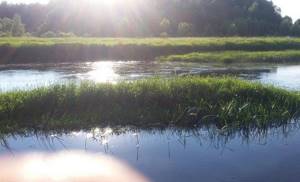
You can catch perch with live bait both in the river and in a still body of water. The criterion for selecting a location is the presence of an area of the reservoir overgrown with aquatic vegetation and a relatively clean zone adjacent to it. The striped robber loves to hunt in the windows of thickets, hiding in underwater bushes and waiting for the victim to come out into the open area. Underwater anomalies of natural origin, holes, rifts, and artificial structures, dams and bridge supports are also promising places.
On rivers, the most catchy places are the borders of contact between fast currents and quiet backwaters and creeks. The predator stands on such lines, collecting fry that are exhausted from fighting the current without spending much effort on catching victims. Snags and trees dumped in the water attract small and large specimens of predators due to their convenient ambush hunting, which should guide the fisherman when selecting a promising fishing point.
Tactics for catching a predator on a float
The fish does not like noise and sudden movements of the fisherman. Having decided on the fishing location, try to behave calmly and confidently, without creating unnecessary activity and fuss. You can catch perch with fry using a float rod both from the shore and from a boat. On a boat, a five-meter rod is not needed; a 3-4-meter rod is enough, because... You can stop right next to an interesting fishing spot.
I catch perch on ponds and lakes from a boat in October - early November, when the water cools and the fish move to deeper parts of the reservoir. By the way, here the probability of catching a striped trophy increases disproportionately. You can search for perch on the river from a boat starting in September. It is especially effective to anchor near small bays and throw the tackle at the border of calm water and river current.
Purposefully catching pike with live bait using a float rod is a real pleasure! The fisherman in this case is practically a hunter, tracking down his prey. Silence, patience and endurance are, of course, the conditions for success in catching any fish, but in this method of catching pike these words take on a special meaning. Pike is, as a rule, a loner, controlling its section of the reservoir, and being able to catch a toothy beauty with a float rod is the pinnacle of any fisherman’s skill.
On ponds and lakes, pike should be looked for behind aquatic vegetation, near obvious snags and trees that have fallen into the water. If you approach an interesting place silently and carefully, make an accurate and quiet cast, then it is likely that the pike will react with lightning speed to the treat offered to it. You can, having placed a couple of float rods, wait for the pike to approach. And here you need both iron endurance and attentiveness so as not to miss a neat bite from the toothy one - and your tackle does not float away after the successful predator. Yes, this happens, but, naturally, among inattentive fishermen.
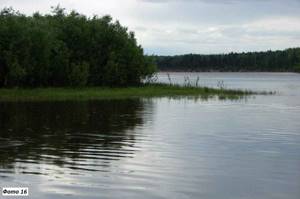
On rivers, pay attention to areas with reverse flows (photo 16) - toothy fish like to spin around here, waiting for exhausted fish. A fallen tree, and a branchy one at that, is a very promising place. Forming behind itself downstream an area with relatively calm water, it cannot but attract fish, including predatory ones. A pile of underwater trash (photo 17) or a bush underwater is also an interesting place that you should definitely check for pike.
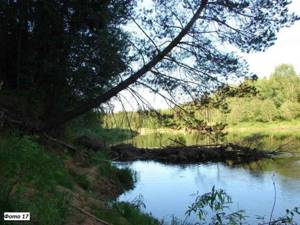
And the most important thing here, I think, is maintaining silence. No need to loom against the sky. If you cast the tackle, sit down or hide behind the vegetation on the shore. I remember that in my youth we even lay down on the ground, watching the floats, only occasionally getting up, and only when it was necessary to rethrow the tackle. I’m already silent about the fact that you don’t need to wear bright clothes on the shore - it’s better to choose dark colors or prefer the now familiar khaki color.
Hooking during such fishing is a very interesting question. As I already said, it often happens that the fisherman does not have the opportunity to wait until the pike has time to swallow the bait, and he has to hook at random. If the predator has not gone far from the meeting place with your live bait, then, of course, you can give her time to swallow the bait. I usually wait 10 - 15 seconds before making a confident hook. Well, or I hook it right away if the fish suddenly moves to the side.
Fishing for a caught pike on a float rod is undoubtedly a great extreme fishing pleasure with adrenaline. A pike caught walking, if its size is more or less large, bends any float rod into an arc, trying with all its might to leave the scene, and here the fisherman needs to be especially careful.
Firstly, do not overdo it and do not pull it straight ahead (in this case there is a possibility of the tackle breaking or the rod breaking), but try to tire it out by carefully controlling and correcting its movements with the help of your tackle.
Secondly, make sure that the pike does not run away into underwater shelters, near which, as a rule, it is caught.
Thirdly, try to prevent the fishing line from becoming slack. This can happen in moments when the pike rushes to the shore or jumps above the surface of the water, making a “candle”. An experienced angler may object at this point - they say, any spinning angler does absolutely the same thing when he pulls out another trophy.
Yes, I agree, but right now it’s worth noting that there is a huge difference in the feeling of this fishing, because you don’t have a powerful spinning rod in your hands, but a relatively delicate float rod! And if you add to this the fact that you don’t “stripe” the river with a wobbler or spinner, but precisely deliver your live bait to an interesting place, wait for a bite, trying to maintain absolute silence, then, believe me, the joy of biting and the pleasure of landing fish will be disproportionately greater than catching a predator with a spinning rod.
You can catch pike this way throughout the open water season. More productive - early autumn. A moment from personal experience: I catch pike with a float rod more effectively from the shore, although, of course, I tried to catch it from a boat. Maybe there was more noise from me, or maybe I didn’t have enough patience to sit still, but from the boat I caught both fewer in quantity and smaller in size, although, in theory, I had access to deeper and, as is commonly believed, more interesting habitats of the toothy predator.
Selection of live bait
When fishing for perch, you can use fry of perch, roach, rudd, and crucian carp as live bait. You can put a small minnow on the hook. Perch is not shy about eating its small brothers. So a small perch can very well become bait for catching a real humpback salmon.
In general, it is worth focusing on the type of fish that is the main food item for perch in a particular reservoir. It’s even better if the live bait is not brought from somewhere, but is caught in the same body of water in which perch fishing takes place.
